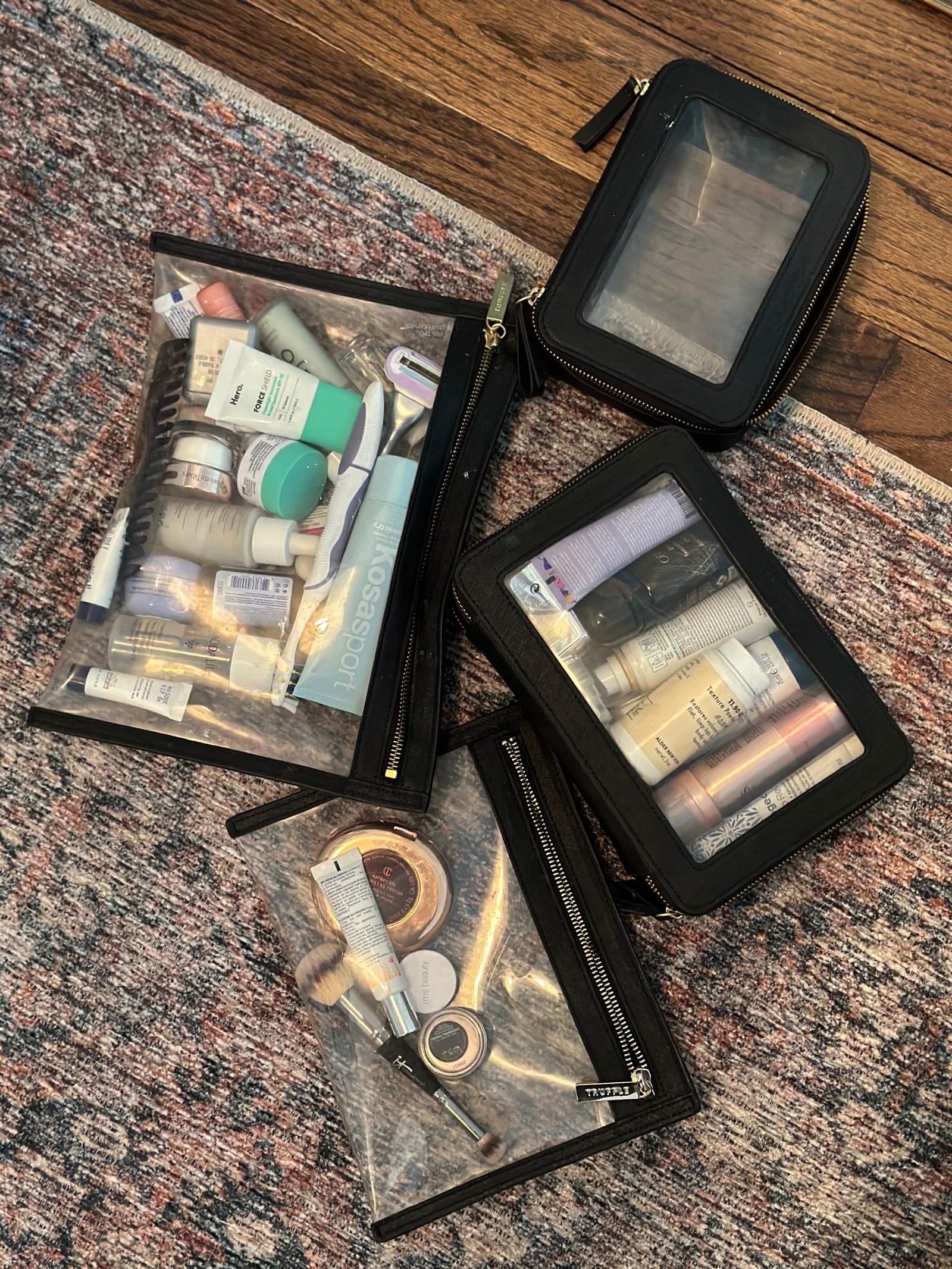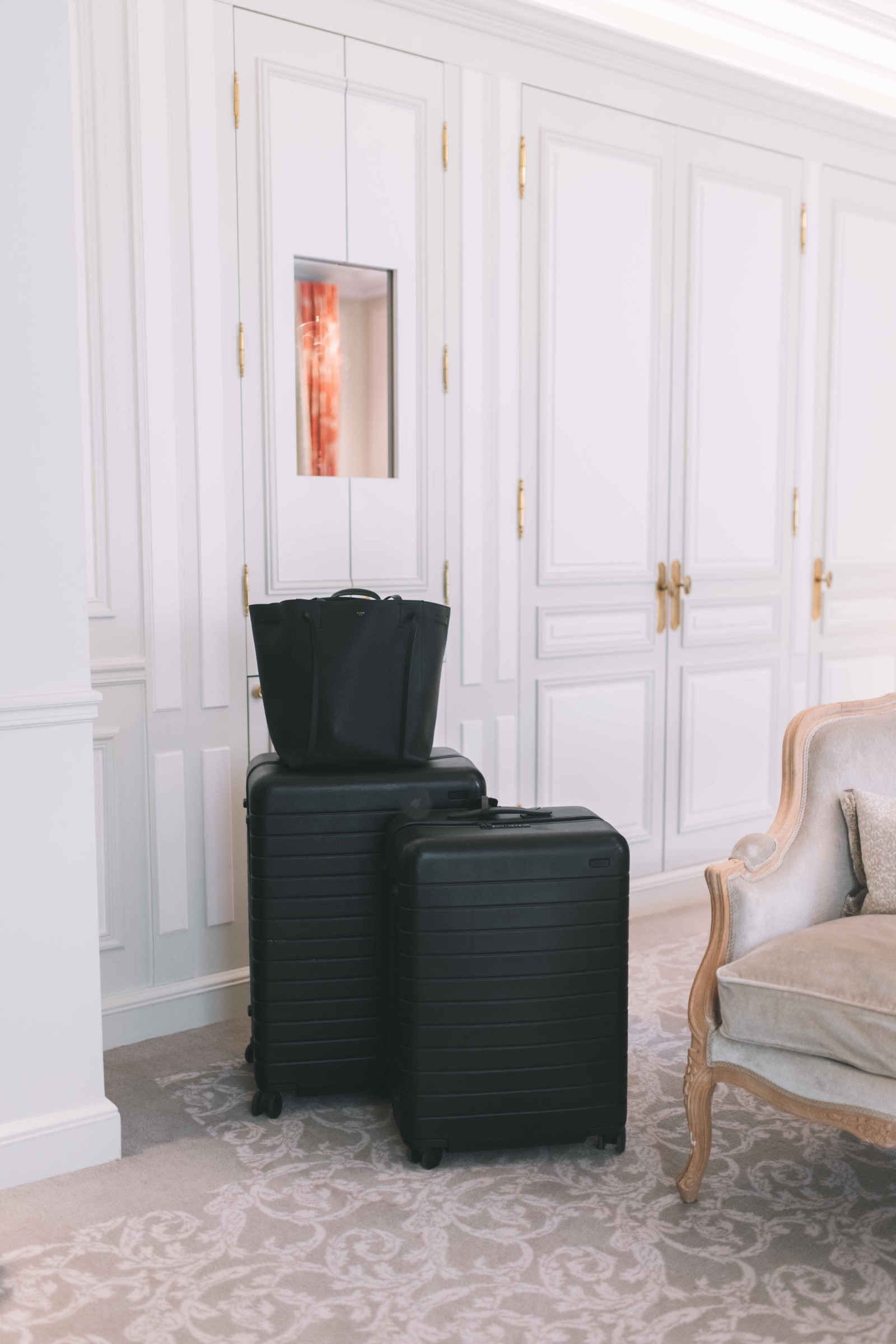Planning a trip to Europe can be exciting, but knowing what to pack is crucial for a smooth and enjoyable experience. At SIXT.VN, we understand the importance of being well-prepared. That’s why we’ve compiled a comprehensive guide on what you must have for Europe travel, ensuring you’re ready to explore iconic landmarks and hidden gems alike. Let SIXT.VN take the stress out of your pre-trip preparations and help you create unforgettable memories with essential travel items.
1. Essential Clothing Items: Packing Smart for Europe
What are the essential clothing items to pack for a trip to Europe? Selecting the right clothing is paramount when traveling to Europe, ensuring comfort and adaptability to various climates and occasions.
-
Mix-and-Match Outfits: Opt for versatile pieces that can be combined in multiple ways to create different looks. This maximizes your wardrobe while minimizing luggage space.
-
Seasonal Essentials: Pack according to the season. Include lightweight layers for summer and insulated garments for winter. This approach ensures you are prepared for varying weather conditions across different regions.
-
Comfortable Footwear: Comfortable shoes are crucial for extensive walking. Consider packing comfortable walking shoes, as you will be doing lots of walking.
 Comfortable Walking Shoes
Comfortable Walking ShoesAlt text: Comfortable sneakers and stylish trousers outfit for walking around Paris.
1.1. What Kind of Clothes Should I Pack for Europe?
Focus on versatile, weather-appropriate clothing when choosing what to pack for Europe. According to research from the European Travel Commission in 2023, packing versatile clothing ensures you are prepared for various activities and weather conditions.
Here’s a detailed list:
- Tops: Pack neutral-colored shirts (both short and long-sleeved), a few dressy blouses, and a sweater or cardigan.
- Bottoms: Include versatile pants or jeans, skirts, and shorts. Jeans are acceptable everywhere now.
- Outerwear: A trench coat, leather jacket, or a versatile blazer is essential.
- Undergarments: Sufficient quantity for the entire trip or plan for laundry.
- Accessories: Scarves, belts, and jewelry to dress up outfits.
1.2. How Many Pairs of Shoes Should I Pack for Europe?
Limit your shoe selection to save space and weight. Limit your shoe selection to save space and weight. According to a 2022 study by Condé Nast Traveler, bringing versatile footwear enhances travel experiences.
- Walking Shoes: 2-3 pairs of comfortable shoes for daytime activities
- Evening Shoes: One pair of dressier shoes for dinners or events
- Optional: Sandals or water shoes, if visiting coastal areas or using public showers
Remember, comfort is key!
1.3. What About Weather-Specific Clothing?
Weather in Europe varies, so check the forecast before packing. According to data from the World Meteorological Organization, weather patterns in Europe can be unpredictable.
- Summer: Lightweight, breathable fabrics, sunglasses, and sunscreen
- Winter: Thermal layers, insulated coats, gloves, hats, and waterproof boots
- Spring/Autumn: Layers, rain jacket, and comfortable walking shoes
- Always: A versatile umbrella or raincoat
2. Essential Toiletries: Staying Fresh on Your European Adventure
What are the essential toiletries to pack for European travel? Maintaining personal hygiene and comfort while traveling is crucial, so packing the right toiletries is essential.
-
Travel-Sized Containers: Opt for mini versions of your favorite skincare and makeup products. Ensure they meet airline liquid restrictions if carrying on.
-
Medications: Pack enough prescription medications for the entire trip, and keep them in your carry-on luggage.
-
Personal Care Items: Include items like toothbrush, toothpaste, shampoo, conditioner, and any other personal care products you use daily.
 Travel Toiletries
Travel ToiletriesAlt text: Organized travel cases with mini toiletries for a trip.
2.1. What Toiletries Can I Bring on a Plane to Europe?
Understanding airline regulations for toiletries is essential. According to guidelines from the European Aviation Safety Agency (EASA) in 2023, restrictions on liquids in carry-on luggage are strict.
- Liquids: Must be in containers no larger than 100ml (3.4 oz)
- Bag: All liquids must fit in a clear, resealable plastic bag, no larger than 20×20 cm (8×8 inches)
- Exceptions: Medications and baby food are often exempt but may require verification
Consider purchasing travel-sized toiletries to comply with these rules.
2.2. Should I Pack a First-Aid Kit for Europe?
A basic first-aid kit is always a good idea, ensuring you’re prepared for minor health issues. According to the World Health Organization in 2022, having a basic first-aid kit can help manage minor injuries and health concerns.
Essential items to include:
- Pain relievers (e.g., ibuprofen, paracetamol)
- Band-aids and antiseptic wipes
- Motion sickness remedies
- Antihistamines
- Any personal medications
2.3. What About Adapting to European Hygiene Standards?
Familiarize yourself with European hygiene practices to ensure comfort. Familiarizing yourself with European standards ensures comfort. According to a 2021 report by the European Centre for Disease Prevention and Control, hygiene standards are generally high, but practices may differ.
- Hand Sanitizer: Carry hand sanitizer for situations where soap and water are unavailable.
- Toiletries: Some public restrooms may not provide soap or paper towels.
- Water: Bottled water is recommended in some regions.
3. Essential Documents: Ensuring Smooth Travel in Europe
What essential documents are needed for traveling in Europe? Traveling to Europe requires careful preparation of essential documents to ensure smooth passage and compliance with local regulations.
-
Passport: Ensure it’s valid for at least six months beyond your planned stay.
-
Visa: Check if you need a visa based on your nationality.
-
Travel Insurance: Documentation of your travel insurance policy.
-
Credit Cards: Credit cards without foreign transaction fees are essential.
 Travel Toiletries
Travel ToiletriesAlt text: Passport and travel documents for a smooth trip.
3.1. What Documents Do I Need to Enter Europe?
Entry requirements vary based on your nationality. The European Commission provides detailed information on visa requirements based on nationality.
Generally, you will need:
- Passport: Valid for at least six months beyond your stay.
- Visa: If required, apply well in advance.
- Proof of Accommodation: Hotel reservations or host details.
- Return Ticket: Evidence of your intention to leave.
3.2. Is Travel Insurance Necessary for Europe?
Travel insurance is highly recommended. The US Department of State advises travelers to have travel insurance for medical emergencies and unforeseen events.
Benefits of travel insurance include:
- Medical coverage
- Trip cancellation/interruption coverage
- Lost or stolen luggage protection
- Emergency evacuation assistance
3.3. How Can I Keep My Documents Safe While Traveling?
Protecting your documents is crucial for a stress-free trip. The US Department of Homeland Security recommends several strategies for keeping travel documents secure.
- Digital Copies: Keep digital copies of all documents on your phone and in the cloud.
- Secure Storage: Use a money belt or secure travel wallet.
- Separate Locations: Store original documents separately from copies.
- Alertness: Be aware of your surroundings to prevent theft.
4. Electronics & Accessories: Staying Connected and Powered Up
What electronics and accessories are essential for traveling in Europe? In today’s digital age, certain electronics and accessories are essential for staying connected, entertained, and powered up during your European travels.
-
Converter: Adapt your devices to European outlets with a universal adapter.
-
Charger: A portable charger is essential for keeping your devices powered on the go.
-
AirTags: Keep track of your luggage by placing AirTags inside.
-
Noise Cancelling Headphones: Wireless noise-canceling headphones are a must for long flights and train rides.
 Electronics and Accessories
Electronics and AccessoriesAlt text: A collection of essential electronics and accessories for European travel.
4.1. Do I Need a Voltage Converter for Europe?
Yes, a voltage converter is necessary for most US electronics. According to information from the International Electrotechnical Commission (IEC), Europe uses 220-240V, while the US uses 110-120V.
- Dual Voltage Devices: Check if your devices are dual voltage (110-240V). If so, you only need a plug adapter.
- Converter: If not, you’ll need a voltage converter to avoid damaging your electronics.
4.2. What’s the Best Way to Stay Connected in Europe?
Staying connected is easier than ever with various options. A 2023 survey by Statista indicates that most travelers prefer using local SIM cards or international roaming plans.
- International Roaming: Check with your mobile provider for international plans.
- Local SIM Card: Purchase a local SIM card for affordable data and calls.
- Portable Wi-Fi Hotspot: Rent a portable Wi-Fi hotspot for reliable internet access.
- Free Wi-Fi: Take advantage of free Wi-Fi in hotels, cafes, and public areas.
4.3. Are Noise-Cancelling Headphones Worth It?
Noise-canceling headphones can significantly improve your travel experience. According to customer reviews on sites like Amazon and Best Buy, noise-canceling headphones enhance comfort during travel.
Benefits include:
- Reducing ambient noise on planes and trains
- Improving sleep quality
- Enhancing focus
- Providing privacy
5. Essential Bags: Choosing the Right Luggage for Europe
What are the essential bags to consider for a trip to Europe? Selecting the right luggage is crucial for a smooth and comfortable trip to Europe.
-
Duffle Bag: A collapsable duffle is great for shopping trips.
-
Luggage: Invest in good suitcases for easy mobility.
-
Travel Backpack: Travel backpacks are a favorite for some travelers.
-
Crossbody Bag: Money belts are a thing of the past, crossbody bags do the trick now.
 Luggage Essentials
Luggage EssentialsAlt text: Away suitcases with luggage tags.
5.1. What Type of Luggage is Best for European Travel?
The best luggage depends on your travel style and itinerary. According to travel experts at Rick Steves, rolling suitcases are ideal for urban travel, while backpacks are better for rugged terrain.
Consider these factors:
- Wheeled Suitcases: Easy to maneuver on smooth surfaces.
- Backpacks: Convenient for cobblestone streets and stairs.
- Carry-On Size: Adhere to airline size restrictions to avoid checked baggage fees.
5.2. Should I Bring a Daypack for Exploring Cities?
A daypack is highly recommended for carrying essentials during daily excursions. According to a survey by Travel + Leisure in 2022, 75% of travelers find a daypack essential for sightseeing.
Essential items to include:
- Water bottle
- Snacks
- Sunscreen
- Map and guidebook
- Camera
5.3. How Can I Prevent Luggage Theft in Europe?
Luggage theft is a concern in tourist areas, so take precautions. The European Travel Information and Authorization System (ETIAS) provides tips on staying safe from theft while traveling.
Strategies to consider:
- Use Luggage Locks: Secure your bags with TSA-approved locks.
- Keep Valuables Close: Store important items in your carry-on bag.
- Be Alert: Pay attention to your surroundings in crowded areas.
- Insure Your Luggage: Ensure your travel insurance covers lost or stolen luggage.
6. Best Packing Tips For Europe: Streamlining Your Suitcase
What are the best packing tips for traveling to Europe? Effective packing can make your European trip more enjoyable.
-
Consider the Weather: Check the weather forecast before you pack.
-
Prepare for Rain: Regardless of the season, pack a good umbrella or raincoat.
-
Consider Getting Around: Check if your accommodations have an elevator.
-
Stick to a Color Palette: Stick to a color palette when you pack for Europe.
 Trench Coat Outfit
Trench Coat OutfitAlt text: Europe travel with a trench coat.
6.1. How Can I Pack Light for Europe?
Packing light can make your trip more manageable. The Minimalists offer practical tips on how to pack light without sacrificing essentials.
Effective strategies include:
- Capsule Wardrobe: Choose versatile clothing items that can be mixed and matched.
- Roll Your Clothes: Rolling clothes saves space and reduces wrinkles.
- Use Packing Cubes: Packing cubes compress items and keep your luggage organized.
- Limit Shoes: Shoes take up a lot of space, so pack only the essentials.
6.2. What Items Should I Leave at Home?
Some items are best left at home to save space and avoid unnecessary hassle. According to expert travel bloggers, avoid packing items like:
- Bulky Hair Dryers
- Excessive Jewelry
- Too Many Books
- Unnecessary Electronics
6.3. How Can I Avoid Overpacking?
Overpacking is a common mistake. Marie Kondo, the organizing expert, recommends packing only items that bring you joy.
Helpful strategies include:
- Make a Packing List: Creating and sticking to a packing list can prevent overpacking.
- Lay Out Everything: Lay out everything you want to pack and then remove 25%.
- Consider Laundry: Plan to do laundry if you’re traveling for an extended period.
- Be Realistic: Be honest with yourself about what you will actually wear.
7. Understanding Local Customs and Etiquette: Being a Respectful Traveler
What is the importance of understanding local customs in Europe? Being aware of and respecting local customs and etiquette can enhance your travel experience and ensure you make a positive impression.
-
Greetings: Learn how to greet people appropriately (e.g., handshake, kiss on the cheek).
-
Dining Etiquette: Understand local dining customs (e.g., tipping, table manners).
-
Dress Code: Be mindful of dress codes for religious sites and cultural events.
-
Language: Learn basic phrases in the local language (e.g., hello, thank you).
 Cafe Scene Paris
Cafe Scene ParisAlt text: Stylish traveler enjoying a cafe in Paris.
7.1. What Are Some Common Cultural Differences to Be Aware Of?
Cultural differences can vary significantly across Europe. The book “Culture Shock! series” provides insights into cultural nuances of different countries.
Key differences to note:
- Personal Space: Respect personal space, which varies across cultures.
- Punctuality: Punctuality is valued in some countries, while others are more relaxed.
- Noise Levels: Be mindful of noise levels in public places.
- Public Displays of Affection: Public displays of affection may be viewed differently in different cultures.
7.2. How Can I Show Respect to Local Traditions?
Showing respect to local traditions can enrich your travel experience. UNESCO provides information on cultural heritage and traditions worldwide.
Strategies include:
- Research: Learn about local customs before you go.
- Observe: Pay attention to how locals behave and follow their lead.
- Ask: Don’t be afraid to ask questions about cultural practices.
- Participate: Engage in local traditions when appropriate.
7.3. What Should I Avoid Doing to Prevent Offending Locals?
Avoiding certain behaviors can prevent unintentional offense. Travel etiquette guides offer advice on avoiding cultural faux pas.
Common mistakes to avoid:
- Loud Talking: Avoid loud talking in quiet places.
- Disrespecting Religious Sites: Dress appropriately and follow rules at religious sites.
- Ignoring Local Laws: Be aware of and respect local laws and regulations.
- Being Impatient: Practice patience and understanding in unfamiliar situations.
8. Transportation Essentials: Navigating Europe with Ease
What transportation essentials are needed for traveling in Europe? Efficient transportation is key to exploring Europe, whether by plane, train, or automobile.
- Rail Pass: Consider purchasing a Eurail pass for extensive train travel.
- Local Transportation Cards: Utilize local transportation cards for cost-effective travel in cities.
- Driving Documents: If driving, ensure you have the necessary driving documents.
- Navigation Tools: Bring reliable navigation tools such as GPS devices or smartphone apps.
8.1. Is It Better to Travel by Train or Plane in Europe?
The best mode of transportation depends on your itinerary. The European Environment Agency reports that train travel is generally more environmentally friendly.
Consider these factors:
- Train: Ideal for scenic routes and city-to-city travel.
- Plane: Faster for long distances, but involves airport procedures.
- Bus: Budget-friendly option for longer distances.
- Car: Offers flexibility for exploring rural areas.
8.2. How Do I Use Public Transportation in European Cities?
Navigating public transportation in European cities can be easy. Citymapper provides real-time public transportation information for many European cities.
Key tips include:
- Buy a Travel Card: Purchase a day or multi-day travel card.
- Download a Transportation App: Use a transportation app for routes and schedules.
- Validate Your Ticket: Validate your ticket before boarding.
- Be Aware of Peak Hours: Avoid peak hours for less crowded travel.
8.3. What Should I Know About Driving in Europe?
Driving in Europe can be a rewarding experience. The AA provides useful information on driving in different European countries.
Important points to consider:
- International Driving Permit: Obtain an International Driving Permit if required.
- Local Traffic Laws: Familiarize yourself with local traffic laws.
- Toll Roads: Be prepared for toll roads in some countries.
- Parking: Understand parking regulations in cities.
9. Health and Safety: Prioritizing Your Well-being
What health and safety precautions should I take for European travel? Prioritizing your health and safety is crucial for a worry-free European adventure.
- Vaccinations: Ensure your vaccinations are up to date.
- Health Insurance: Confirm your health insurance covers international travel.
- Emergency Contacts: Carry a list of emergency contacts.
- Local Emergency Numbers: Know the local emergency numbers.
9.1. What Vaccinations Do I Need for Europe?
Vaccination requirements vary depending on your destination. The Centers for Disease Control and Prevention (CDC) provides detailed information on recommended vaccinations.
Commonly recommended vaccines include:
- Measles, Mumps, Rubella (MMR)
- Tetanus, Diphtheria, Pertussis (Tdap)
- Hepatitis A and B
- Typhoid (if traveling to certain regions)
9.2. How Can I Stay Safe from Pickpockets in Europe?
Pickpockets are common in tourist areas. The US Department of State offers tips on protecting yourself from pickpockets.
Strategies include:
- Be Aware of Your Surroundings: Pay attention to your surroundings, especially in crowded areas.
- Use Anti-Theft Bags: Consider using anti-theft bags or wallets.
- Keep Valuables Hidden: Keep valuables out of sight.
- Don’t Flash Cash: Avoid displaying large amounts of cash.
9.3. What Should I Do in Case of a Medical Emergency?
Knowing what to do in a medical emergency can save lives. The European Emergency Number Association (EENA) provides information on emergency services in Europe.
Key steps to take:
- Call the Local Emergency Number: Dial 112 for all emergencies.
- Seek Medical Attention: Go to the nearest hospital or clinic.
- Contact Your Insurance Company: Notify your insurance company as soon as possible.
- Keep Records: Keep records of all medical treatments and expenses.
10. Financial Essentials: Managing Your Money Wisely
What financial essentials are needed when traveling to Europe? Wise financial management is key to a stress-free European trip.
- Credit Cards: Bring credit cards without foreign transaction fees.
- Debit Card: Have a debit card for ATM withdrawals.
- Cash: Carry some local currency for small purchases.
- Budget: Create a budget and track your expenses.
10.1. What’s the Best Way to Exchange Currency for Europe?
Exchanging currency wisely can save you money. Forbes Advisor provides tips on the best ways to exchange currency.
Consider these options:
- ATM: Withdraw cash from ATMs for the best exchange rates.
- Credit Cards: Use credit cards for larger purchases.
- Avoid Airport Kiosks: Avoid exchanging currency at airport kiosks, which often have high fees.
- Order Online: Order currency online from your bank before you leave.
10.2. How Much Cash Should I Carry in Europe?
The amount of cash you need depends on your spending habits. The Points Guy recommends carrying enough cash for small purchases and emergencies.
General guidelines include:
- Small Purchases: Carry enough cash for small purchases, such as coffee or snacks.
- Emergencies: Have some cash on hand for emergencies.
- Tip in Cash: Some service providers prefer to be tipped in cash.
- Avoid Carrying Large Amounts: Avoid carrying large amounts of cash to minimize risk.
10.3. What Should I Do If My Credit Card Is Lost or Stolen?
Knowing what to do if your credit card is lost or stolen is crucial. The Federal Trade Commission (FTC) provides guidance on reporting lost or stolen credit cards.
Key steps to take:
- Report Immediately: Report the loss or theft to your credit card company immediately.
- Cancel the Card: Cancel the card to prevent unauthorized charges.
- Monitor Your Account: Monitor your account for any suspicious activity.
- File a Police Report: File a police report if necessary.
FAQ: Must-Haves For Europe Travel
1. What is the most important thing to pack for Europe?
Your passport is undoubtedly the most crucial item to pack. It’s your primary form of identification and is required for international travel. Always ensure it’s valid for at least six months beyond your planned stay in Europe.
2. What kind of adapter do I need for Europe?
Most European countries use Type C or Type F plugs, which have two round pins. If your devices use different plugs, you’ll need a universal adapter.
3. How much money should I bring to Europe for 2 weeks?
The amount of money you should bring depends on your travel style and destination. Budget travelers might spend around $70-$100 per day, while those seeking a more luxurious experience could spend $200 or more.
4. What clothes should I not bring to Europe?
Avoid bringing overly flashy or conspicuous clothing that makes you stand out as a tourist. Also, avoid packing clothes that are uncomfortable or impractical for walking long distances.
5. Is it safe to drink tap water in Europe?
Tap water is generally safe to drink in most Western European countries. However, in some Eastern European countries, it’s best to drink bottled water.
6. Do I need to know the local language to travel in Europe?
While it’s not always necessary to know the local language, learning a few basic phrases can greatly enhance your experience and is often appreciated by locals.
7. What is the best way to get around Europe cheaply?
Consider traveling by bus or train for a more affordable option. Additionally, look for budget airlines and book accommodations with free breakfast.
8. What are some must-try foods in Europe?
Must-try foods vary by country, but some popular options include pizza in Italy, croissants in France, paella in Spain, and beer in Germany.
9. How can I avoid tourist traps in Europe?
To avoid tourist traps, do your research ahead of time and seek recommendations from locals. Visit lesser-known areas and be wary of overpriced restaurants and attractions.
10. What should I do if I lose my passport in Europe?
If you lose your passport, contact your embassy or consulate immediately. They can assist you with obtaining a replacement passport and provide guidance on next steps.
Planning a trip to Europe requires careful preparation, but with the right essentials, you can ensure a smooth and enjoyable experience. From clothing and toiletries to documents and electronics, each item plays a crucial role in your journey.
At SIXT.VN, we understand the importance of hassle-free travel. That’s why we offer a range of services to make your trip to Vietnam seamless, including airport transfers, hotel bookings, and tours of Hanoi. With SIXT.VN, you can focus on creating unforgettable memories while we take care of the details. Contact us today at +84 986 244 358 or visit our website at SIXT.VN to learn more about our services and start planning your dream trip to Vietnam. Our address is 260 Cau Giay, Hanoi, Vietnam, and we’re always ready to assist you with your travel needs. Let SIXT.VN be your trusted partner in exploring the beauty and culture of Vietnam.



